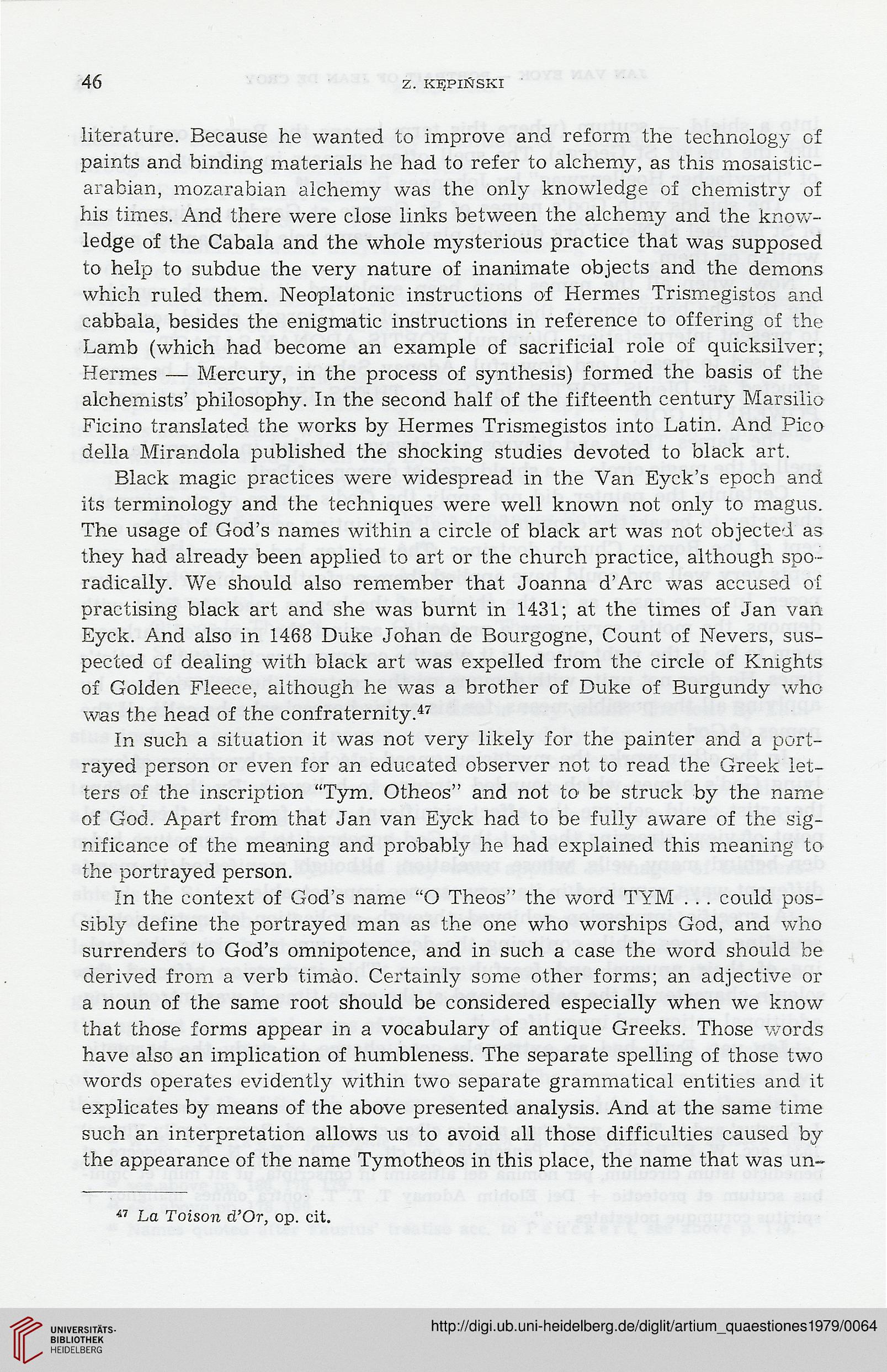46
Z. KĘPIŃSKI
literaturę. Because he wanted to improve and reform the technology of
paints and binding materials he had to refer to alchemy, as this mosaistic-
arabian, mozarabian alchemy was the only knowledge of chemistry of
his times. And there were close links between the alchemy and the know-
ledge of the Cabala and the whole mysterious practice that was supposed
to help to subdue the very naturę of inanimate objects and the demons
which ruled them. Neoplatonic instructions of Hermes Trismegistos and
cabbala, besides the enigmatic instructions in reference to offering of the
Lamb (which had become an example of sacrificial role of quicksilver;
Hermes — Mercury, in the process of synthesis) formed the basis of the
alchemists’ philosopby. In the second half of the fifteenth century Marsilio
Ficino translated the works by Hermes Trismegistos into Latin. And Pico
della Mirandola published the shocking studies devoted to black art.
Black magie practices were widespread in the Van Eyck’s epoch and
its terminology and the techniąues were well known not only to magus.
The usage of God’s names within a circle of black art was not objected as
they had already been applied to art or the church practice, although spo-
radically. We should also remember that Joanna d’Arc was accused of
practising black art and she was burnt in 1431; at the times of Jan van
Eyck. And also in 1468 Duke Johan de Bourgogne, Count of Nevers, sus-
pected of dealing with black art was expelled from the circle of Knights
of Golden Fleece, although he was a brother of Duke of Burgundy who
was the head of the confraternity.47
In such a situation it was not very likely for the painter and a port-
rayed person or even for an educated observer not to read the Greek let-
ters of the inscription “Tym. Otheos” and not to be struck by the narne
of God. Apart from that Jan van Eyck had to be fully aware of the sig-
nificance of the meaning and probably he had explained this meaning to
the portrayed person.
In the context of God’s name “O Theos” the word TYM . . . could pos-
sibly define the portrayed man as the one who worships God, and who
surrenders to God’s omnipotence, and in such a case the word should be
derived from a verb tirnao. Certainly some other forms; an adjective or
a noun of the same root should be considered especially when we know
that those forms appear in a vocabulary of antiąue Greeks. Those words
have also an implication of humbleness. The separate spelling of those two
words operates eyidentły within two separate grammatical entities and it
explicates by means of the above presented analysis. And at the same time
such an interpretation allows us to avoid all those difficulties caused by
the appearance of the name Tymotheos in this place, the name that was un~
47 La Toison d’Or, op. cit.
Z. KĘPIŃSKI
literaturę. Because he wanted to improve and reform the technology of
paints and binding materials he had to refer to alchemy, as this mosaistic-
arabian, mozarabian alchemy was the only knowledge of chemistry of
his times. And there were close links between the alchemy and the know-
ledge of the Cabala and the whole mysterious practice that was supposed
to help to subdue the very naturę of inanimate objects and the demons
which ruled them. Neoplatonic instructions of Hermes Trismegistos and
cabbala, besides the enigmatic instructions in reference to offering of the
Lamb (which had become an example of sacrificial role of quicksilver;
Hermes — Mercury, in the process of synthesis) formed the basis of the
alchemists’ philosopby. In the second half of the fifteenth century Marsilio
Ficino translated the works by Hermes Trismegistos into Latin. And Pico
della Mirandola published the shocking studies devoted to black art.
Black magie practices were widespread in the Van Eyck’s epoch and
its terminology and the techniąues were well known not only to magus.
The usage of God’s names within a circle of black art was not objected as
they had already been applied to art or the church practice, although spo-
radically. We should also remember that Joanna d’Arc was accused of
practising black art and she was burnt in 1431; at the times of Jan van
Eyck. And also in 1468 Duke Johan de Bourgogne, Count of Nevers, sus-
pected of dealing with black art was expelled from the circle of Knights
of Golden Fleece, although he was a brother of Duke of Burgundy who
was the head of the confraternity.47
In such a situation it was not very likely for the painter and a port-
rayed person or even for an educated observer not to read the Greek let-
ters of the inscription “Tym. Otheos” and not to be struck by the narne
of God. Apart from that Jan van Eyck had to be fully aware of the sig-
nificance of the meaning and probably he had explained this meaning to
the portrayed person.
In the context of God’s name “O Theos” the word TYM . . . could pos-
sibly define the portrayed man as the one who worships God, and who
surrenders to God’s omnipotence, and in such a case the word should be
derived from a verb tirnao. Certainly some other forms; an adjective or
a noun of the same root should be considered especially when we know
that those forms appear in a vocabulary of antiąue Greeks. Those words
have also an implication of humbleness. The separate spelling of those two
words operates eyidentły within two separate grammatical entities and it
explicates by means of the above presented analysis. And at the same time
such an interpretation allows us to avoid all those difficulties caused by
the appearance of the name Tymotheos in this place, the name that was un~
47 La Toison d’Or, op. cit.




